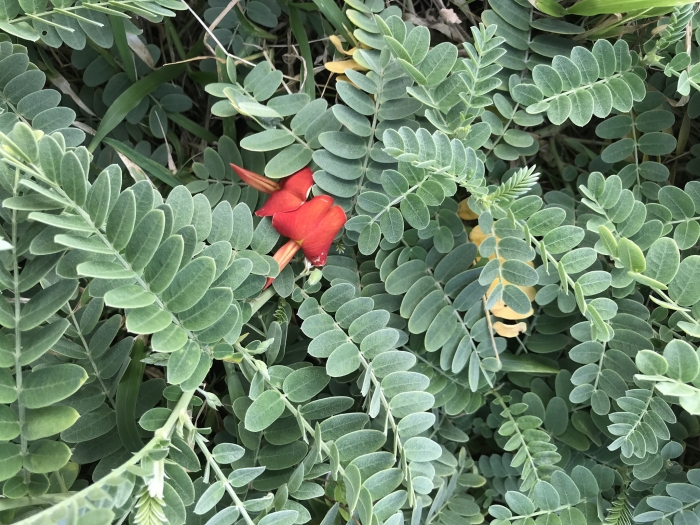Oahu Riverhemp And ʻōhai
(Sesbania tomentosa)
Oahu Riverhemp And ʻōhai (Sesbania tomentosa)
/
/

Bruce Bailey
CC BY 4.0
Image By:
Bruce Bailey
Recorded By:
Copyright:
CC BY 4.0
Copyright Notice:
Photo by: Bruce Bailey | License Type: CC BY 4.0 | License URL: http://creativecommons.org/licenses/by/4.0/ | Rights Holder: Bruce Bailey | Publisher: iNaturalist | Date Created: 2019-01-14T00:37:19Z |

























Estimated Native Range
Summary
Sesbania tomentosa, commonly known as Oahu riverhemp and ʻōhai, is a deciduous shrub or small tree endemic to the Hawaiian Islands, including the main islands, Nihoa, and Necker Island. It is typically found in coastal dry shrublands and dry forests up to 2,500 feet in elevation, where it is an important component of the native flora, often growing in sandy or rocky substrates with species such as akiʻaki (Sporobolus virginicus) and naupaka kahakai (Scaevola taccada). Sesbania tomentosa can reach up to 10 feet in height and is noted for its silver-gray, tomentose (hairy) foliage that provides a unique texture in the landscape. It produces striking yellow flowers that bloom from summer to fall, adding a splash of color to its surroundings.
The plant is valued for its ornamental qualities, particularly its attractive foliage and flowers. It is suitable for xeriscaping due to its adaptation to dry conditions and can be used in restoration projects to stabilize soils and support native ecosystems. In cultivation, Sesbania tomentosa requires well-drained soils, full sun to partial shade, and minimal water once established, making it relatively low maintenance. However, it is susceptible to root rot if overwatered and should be monitored for pests such as aphids and mealybugs. Due to its rarity, it is not commonly found in cultivation, but it holds potential for use in native plant gardens and ecological landscaping in Hawaii.CC BY-SA 4.0
The plant is valued for its ornamental qualities, particularly its attractive foliage and flowers. It is suitable for xeriscaping due to its adaptation to dry conditions and can be used in restoration projects to stabilize soils and support native ecosystems. In cultivation, Sesbania tomentosa requires well-drained soils, full sun to partial shade, and minimal water once established, making it relatively low maintenance. However, it is susceptible to root rot if overwatered and should be monitored for pests such as aphids and mealybugs. Due to its rarity, it is not commonly found in cultivation, but it holds potential for use in native plant gardens and ecological landscaping in Hawaii.CC BY-SA 4.0
Plant Description
- Plant Type: Shrub
- Height: 5-15 feet
- Width: 5-8 feet
- Growth Rate: Moderate
- Flower Color: Orange, Red, Yellow
- Flowering Season: Spring, Summer, Fall, Winter
- Leaf Retention: Evergreen
Growth Requirements
- Sun: Full Sun, Part Shade
- Water: Low
- Drainage: Fast, Medium
Common Uses
Bee Garden, Bird Garden, Butterfly Garden, Drought Tolerant, Hummingbird Garden, Low Maintenance, Showy Flowers
Natural Habitat
Coastal dry shrublands and dry forests up to 2,500 feet in elevation, often on sandy or rocky substrates
Other Names
Common Names: Ohai, Ohai Ula, `Ohai, Yellow Ohai
Scientific Names: , Sesbania tomentosa, Agati tomentosa, Agati tomentosa, Emerus tomentosus, Sesbania arborea, Sesbania hawaiiensis, Sesbania hobdyi, Sesbania molokaiensis, Sesbania tomentosa var. molokaiensis,
GBIF Accepted Name: